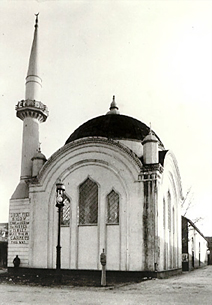
By Maria Rosa Menocal
The lessons of history, like the lessons of religion, sometimes neglect examples of tolerance. A thousand years ago on the Iberian Peninsula,<注1> an enlightened vision of Islam<注2> had created the most advanced culture in Europe.
Al Andalus,<注3> as the Muslims called their Spanish homeland, prospered in a culture of openness and assimilation.<注4> A nun named Hroswitha, called it "the ornament of the world." <注5>Her admiration stemmed from the cultural prosperity of the caliphate<注6> based in Cordoba, <注7> where the library housed some 400,000 volumes at a time when the largest library in Christendom<注8> probably held no more than 400.
What strikes us today about Al Andalus is that it was a chapter of European history during which Jews, Christians and Muslims lived side by side and, despite intractable differences and enduring hostilities, <注9> nourished a culture of tolerance.
This only sometimes meant guarantees of religious freedoms comparable to those we would expect in a modern "tolerant"state. Rather, it was the often unconscious acceptance of contradictions on an individual level as well as within the culture itself.<注10>
For many who came to know Andalusian culture throughout the Middle Ages, whether at first hand or from afar—from reading a translation produced there or from hearing a poem sung by one of its renowned singers—the bright lights of that world, and their illumination of the rest of the universe, transcended differences of religion.
It was in Al Andalus that the profoundly Arabized Jews rediscovered and reinvented Hebrew poetry. Much of what was created and instilled<注11> under Muslim rule survived in Christian territories, and Christians embraced nearly all aspects of Arabic style—from philosophy to architecture.
Christian palaces and churches, like Jewish synagogues,<注12> were often built in the style of the Muslims, the walls often covered with Arabic writing; one synagogue in Toledo even includes inscriptions from the Koran.<注13>
And it was throughout medieval Europe that men of unshakable faith like the two great philosophers of Al Andalus, Maimonides<注14> the Jew and Averroes <注15> the Muslim, saw no contradiction in pursuing the truth, whether philosophical or scientific or religious, across confessional lines.<注16>
This was an approach to life—and its artistic, intellectual and religious pursuits—that was contested by many, sometimes violently, as it is today. Yet it remained a powerful force for hundreds of years.
Whether it is because of our mistaken notions about the relative backwardness of the Middle Ages or our own contemporary expectations that culture, religion and political ideology will be roughly consistent, we are likely to be taken aback by many of the lasting monuments of this Andalusian culture.<注17>
The caliphate was not destroyed, as our cliches of the Middle Ages<注18> would have it, by Christian-Muslim warfare. It lasted for several hundred years—roughly the lifespan of the American republic to date—and its downfall was a series of terrible civil wars among Muslims.
These wars were a struggle between the old ways of the caliphate—with its libraries filled with Greek texts and its government staffed by non-Muslims—and reactionary Muslims, many of them from Morocco,<注19> who believed the Cordobans were not proper Muslims.
But in the end, much of Europe far beyond the Andalusian world was shaped by the vision of complex and contradictory identities that was first made into an art form by the Andalusians. The enemies of this kind of cultural openness have always existed within each of our monotheistic religions,<注20> and often enough their visions of those faiths have triumphed.
But at this time of year, and at this point in history, we should remember those moments when it was tolerance that won the day.-
阅读感评
叶向阳
一提到基督教与伊斯兰教世界之间的关系,我们的脑海中马上会浮现出两大历史事件:十字军东征和摩尔人铁腕统治西班牙。一个是欧洲人向东讨伐异教徒,一个是穆斯林西进君临基督教世界。这两件事都发生在中世纪,而中世纪的形象无疑是与宽容背道而驰的宗教裁判所。
想不到,不久前在《国际先驱论坛报》(International Herald Tribune)上读到了一篇与我们对中世纪的印象颇有出入的文章。作者是耶鲁大学的教授,其《异彩纷呈的世界:穆斯林、犹太人和基督徒如何在中世纪的西班牙创造了一个宽容的文化》一书即将出版。据称,穆斯林与犹太人曾有过一段“互相宽容、和睦相处”的佳话。而且时间恰好就在中世纪,地点就在西班牙。看来,历史的多样性和复杂性在经历了一千年之后确实是被大大地简化了。文章说,西班牙的安达卢西亚(Al Andalus)揭开了欧洲历史的新篇章。尤其在科多巴(Cordoba)的哈里发辖地(Caliphate),犹太人、基督徒和穆斯林摈弃纷争与对抗,比邻而居,培育了一种宽容的文化。在那儿,阿拉伯化了的犹太人再一次发现并发明了希伯来诗歌。穆斯林在基督教领土上统治时留下的物质和精神遗产大多能幸存下来;而且,基督徒上至哲学下至建筑均能包容阿拉伯的风格。如当时的一些犹太教堂的墙上甚至还写满阿拉伯文字。其中一处还刻有《古兰经》。文章还指出,在中世纪的数百年时间里,欧洲出现了一些像迈蒙尼德、阿威罗伊那样各自有坚定的信仰,又能跨越教派的界线去追求真理而不致冲突的著名学者、思想家;即使是基督徒-穆斯林之间的战争,也没有摧毁哈里发的辖地。这样一个图书馆里藏有大量希腊文作品,政府部门雇佣非穆斯林职员的异彩纷呈的文明世界一直延续了两、三百年,相当于今日美利坚合众国的历史。
看看今日的中东乃至世界,我们不得不感慨于西方的一句格言:What we learn from history is that we have never learned from history (我们从历史那里得到的教训是我们从不吸取历史的教训)。
1918年,当时在巴勒斯坦的英国殖民者允许犹太人在这片已属于阿拉伯人的领土上建立以色列国,从那时起,巴以冲突已持续了近一个世纪。三次中东战争,以色列主要在美国的支持下打败了阿拉伯人,侵占了阿拉伯世界特别是巴勒斯坦大量领土,拒不归还,还在巴勒斯坦的领土上建了数百个定居点,大有永久吞并的企图。当今所谓的巴勒斯坦“自治领土”只占原来巴勒斯坦地区的23%,而且还被以色列分割成一块块“飞地”,巴勒斯坦人来往于自己的土地之间都要经过以色列哨卡士兵的层层盘问和搜身。不仅人格常常受到侮辱,有时还有生命危险。巴勒斯坦人一直有一个梦想:建立巴勒斯坦国。但是,由于以色列的阻挠,这个愿望至今仍无法实现,而且遥遥无期。以色列想要的只是停火,即要巴勒斯坦人放弃抵抗;而巴勒斯坦人想要的是建国;二者之间的差距何其大!
二战期间的犹太人是最值得同情的,因为纳粹德国对犹太人实施种族灭绝政策,屠杀了六百万犹太人。但是,分布在全世界,有上千万人口的犹太人作为一个民族不会灭亡。而二战后至今,苦难最为深重的民族无疑是巴勒斯坦人,他们失去了自己的家园,基本上手无寸铁,却遭受世界上最先进、最残忍的武器的袭击。然而同犹太人当年一样,拥有六百万民众的巴勒斯坦,即使圣殿被捣毁、领袖遭逮捕、人民被杀戮,作为一个民族,它也将永存下去。
就是这样的两个民族,它们既然永远也不能完全把对方“吃”掉,本应该较为宽容、现实地"Live and let live",而结果却是一方一意孤行要强行"Bully and make bullied"。令人不解的是这种做法还受到其民众的拥护与大国的支持。显然,这里宽容已被欺压与仇恨代替。在双方都已几乎失去理智的时候,用文化去解释已显得力不从心,因为思维已简单化为“暴力与复仇”,这是动物都具备的直觉。
十八个月来,巴勒斯坦人用石块,以色列人还以枪弹;巴勒斯坦人用枪弹,以色列人还以大炮与火箭;巴勒斯坦人用人体炸弹,以色列人还以F-16、Apache、导弹甚至暗杀抵抗组织的领导人直至占领巴勒斯坦全境;到了今天,巴勒斯坦青年急于要与占领者同归于尽成为烈士,而沙龙则扬言“We have to cause them heavy casualties"......这是一个典型的以牙还牙、以血偿血(Eye for eye, blood for blood)的轮回,直至不可收拾。我们往往只知道伊斯兰教有"圣战(Jihad)”,却并不清楚犹太教圣经的《旧约》里的上帝也有血腥与疯狂报复的一面。当然,穆斯林也不是不知道“Killing innocent people is not Islamic”(Mahathir bin Mohamad, Prime Minister of Malaysia),古代以色列先知以塞亚(Isaiah)也讲过“undo the heavy burdens...(and) let the oppressed go free”以告慰苦难中的以色列人。不过这些话,在今天“占领与抵抗,报复与反报复”的两个针锋相对的民族听来只不过是耳边风而已。
苏联解体、冷战结束时,无数人欢呼世界多极化的到来;进入九十年代后,某位并不重要的西方政治家的一句“二十一世纪是亚洲的世纪”激起了多少中国人的热情与自信。十多年过去了,遗憾的是,我们似乎离这些美好的理想越来越远,世界的纷争与不对等的抗争愈演愈烈。冷战时期的“两极”并没有走向“多极”,而是出现了我们最不愿意看到的以一国为核心的“世界独裁”局面。
“9·11”以后,布什政府已简单地把世界划分为两个阵营:恐怖主义与反恐怖主义。而且,他们只对恐怖主义“是什么”感兴趣,坚决不提也不允许别人提其背后的“为什么”。要是依他们的“是否袭击平民”为惟一标准,那么几乎所有历史和现实中的民族抵抗与解放运动都要被冠名为“恐怖主义”,其中包括二战中的反法西斯抵抗运动,犹太复国主义运动,以色列建国初期抗击阿拉伯世界,甚至还包括美国独立战争,以及美国内战。因为它们都不同程度地对平民造成了伤害,甚至直接袭击平民或不设防的城市以制造恐怖使敌人就范。但很显然,以上事例不管被称为运动还是战争,其“成分”绝不会被美国及其盟友划为“恐怖主义”,因为攻击者来自“自由世界”或是他们的同盟者,被袭击者则属于“自由世界”阵营以外的Rogues。这样简单的“成分”一旦划定,他们对付所谓的“恐怖主义”的方法很简单:要么投降,要么消灭。以色列现在已心领神会:一旦巴勒斯坦人抵抗,就会引来一片“恐怖主义”的谴责声;而用美式最新武器装备到牙齿的以色列军队摧毁巴勒斯坦的难民营、暗杀其他国家和地区的领导人却被标榜为“自卫反击”;难怪它的胆子会越来越大。由此我不禁想起这次法国总统选举,一位共产党候选人让“Internationale”的旋律一次次响起,会场群情激昂,也令我热血沸腾。“巴黎公社”一百三十余年后,在这个所谓的“全球化”时代,我们是沿着“英特纳雄耐尔”这个曾是多少代人的理想向前走呢,还是与她背道而驰?
其实,当世界一头扎进今日地球上惟一超级大国的“单边主义”时,学术界一刻也没有停止过对“政治、文化多元”的探讨与追求。学者们反对“西方中心主义”,呼吁各种政治体制、文化传统能“和而不同”或至少是“求同存异”,希望给当今并不太平的世界营造类似中世纪安达卢西亚的那种宽容平和的氛围。其实“多元”本身就是妥协与宽容的结果,当然在当今世界,要达到此目的还要有一个物质前提:不妥协、不宽容只会鸡飞蛋打、两败俱伤。但是,在这个几乎是一个国家、一种体制、一种文明说了算的时代,中世纪安达卢西亚的灯光还足以照亮我们前行的路吗?
The writer, a professor of Spanish and Portuguese at Yale University, is author of the forthcoming The Ornament of the World: How Muslims, Jews and Christians Created a Culture of Tolerance in Medieval Spain.* She contributed this comment to The New York Times.
*本文作者,耶鲁大学西班牙语与葡萄牙语教授。其著作《异彩纷呈的世界:穆斯林、犹太人和基督徒如何在中世纪的西班牙创造了一个宽容的文化》即将出版。
| ![]() 本网站由北京信息港提供网络支持
本网站由北京信息港提供网络支持